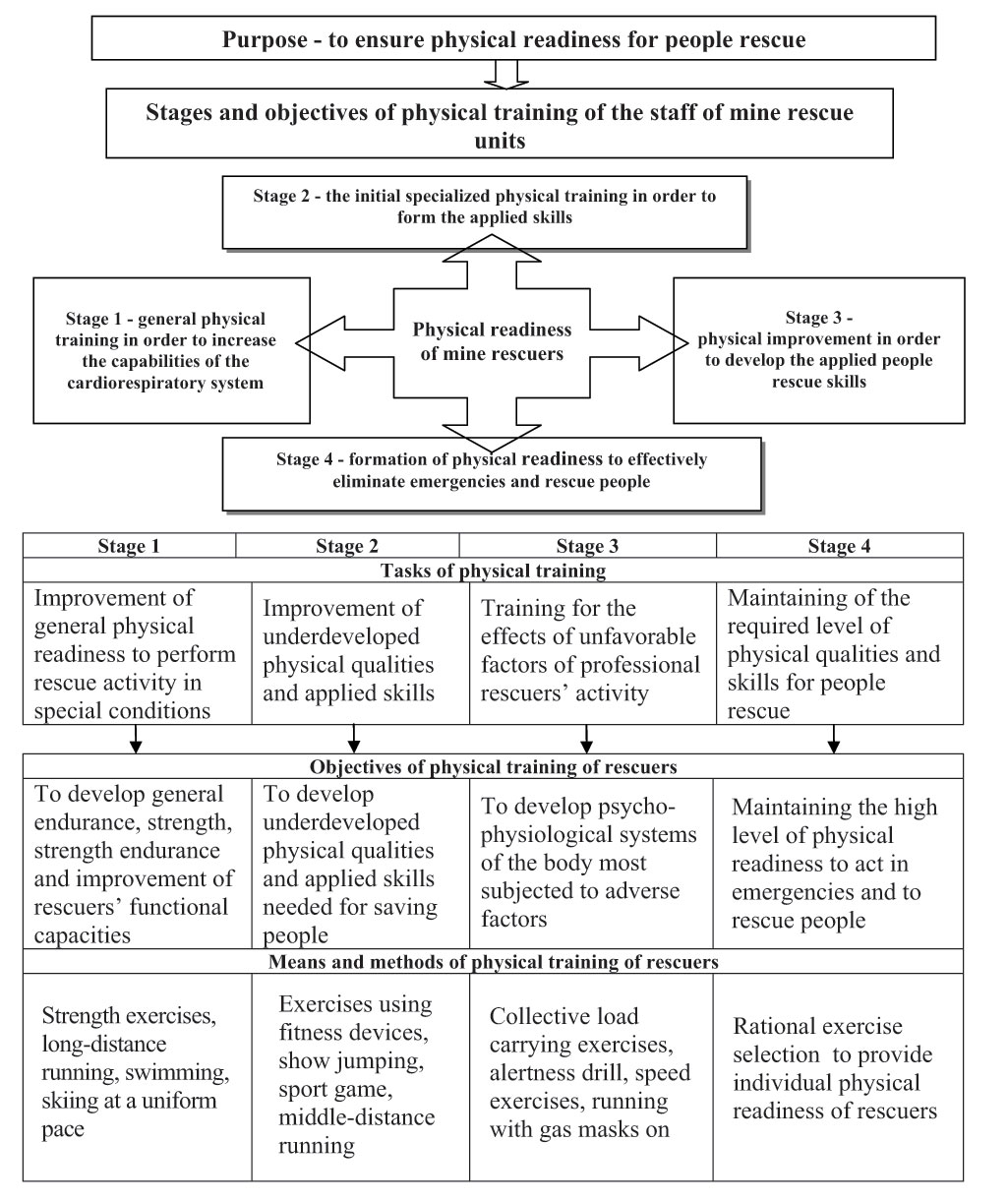Educational Model of Physical Fitness of Staff of Mine-Rescue Units
Фотографии:
ˑ:
I.A. Panchenko, associate professor, Ph.D.
A.V. Volkov, senior teacher, Honored trainer of Russia
National Mineral Resources University “Mining”, St. Petersburg
A.E. Bolotin, professor, Dr.Hab., Honorary worker of higher school of the RF
St. Petersburg state polytechnic university, St. Petersburg
Key words: mine rescues, staff of mine rescue units, professional activity, physical readiness, educational model.
Enhancement of the mineral resource industry is accompanied by complication of technical equipment, mining conditions and new field development. This happens in remote areas, often in harsh regions of the Far North. Field development in such an environment is accompanied by an increase in the number of emergencies and accidents at mining sites. Therefore, the problem of people rescue and liquidation of accidents at such facilities is relevant. The rescue service is responsible for this problem.
The purpose of the present study was to make a scientific substantiation of the model of physical readiness of staff of mine-rescue units for work in extreme environment.
Mine-rescue units are intended for liquidation of emergency situations. The concern for health of the people working in the mineral resource industry makes especially severe requirements to the level of professional and physical readiness of the staff of mine-rescue units for working in extreme conditions.
The analysis of the practice of formation of physical readiness of the staff of mine-rescue units for emergency activities shows that the matters related to their training are still unsolved.
Formation of physical readiness of the staff of mine rescue units is focused mainly on the improvement of professional knowledge. But the interrelation of all the components in the structure of physical readiness for emergencies is not considered. Using existing techniques for assessing rescuers’ physical readiness one can judge only about the level of physical readiness, but cannot estimate motor abilities and expert skills to perform functional duties in extreme situations of people rescue.
The success of the staff of mine rescue units acting under the impact of unfavorable factors while performing the tasks of people rescue largely depends on their physical readiness for such activities [1]. The improvement of physical readiness of the staff of mine rescue units so they could act in emergency conditions is currently one of the main tasks for maintaining the life safety of miners and other professionals working in the mining industry. Recent studies show that the most relevant issue is the lack of pedagogical model necessary to ensure physical readiness of the staff of mine rescue units to work in emergency situations. It will significantly improve the effectiveness of their professional life-saving activities [2].
Results and discussion. A model of physical readiness of the staff of mine rescue units to work in emergency situations has been developed during the study. The model is presented in Fig.1.
This model is designed to close the gap between the existing theoretical knowledge and practical requirements in the formation of physical readiness of the staff of mine rescue units to work in emergencies.
High demands are placed on rescuers’ physical readiness due to specific features of their work. Working with self-contained breathing apparatus and extreme activities of people rescue at high environment temperatures require great psychophysiological reserves. The health of both the rescuers and the people they're helping depends largely on the level of physical readiness.

Fig. 1. Model of physical readiness of the staff of mine rescue units
The efficiency of the designed model of physical readiness of the staff of mine rescue units to work in emergencies was verified in an educational experiment. Its results indicate the high efficiency of the developed educational model. Functional state and physical readiness indicators of the subjects in the experimental group were significantly higher than those in the control group.
The results in complex professional tasks performed by the subjects of the control and the experimental groups during tactical exercises objectively indicate the high efficiency of the developed model of physical readiness of the staff of mine rescue units to act in emergency situations.
At the end of the educational experiment the results in the experimental group (EG) were as follows: 38,2% of rescuers had “high” level of physical readiness for work; 32,2% - “above average”; 21,3% - “average” and 8,3% - “low”.
The results in the control group (CG): 13,7% of rescuers - “high” level; 20,3% - “above average”; 37,3% - “average” and 28,7% - “low”.
Conclusion. This study has shown high efficiency of the developed educational model of physical readiness of the staff of mine rescue units to work in emergency situations.
References
- Bolotin, A.E. Demands to professional training of security professionals in emergencies / A.E. Bolotin, V.S. Vasil'eva // Uchenye zapiski universiteta im. P.F. Lesgafta. – 2013. – № 6(100). – P. 15-21. (In Russian)
- Bolotin, A.E. The educational model of professional training of specialist in protection in emergency situations in a university using official activities in volunteer fire brigades / A.E. Bolotin, V.S. Vasil'eva // Uchenye zapiski universiteta im. P.F. Lesgafta. – 2013. – № 2 (96). – P. 14-19. (In Russian)
Corresponding author: Panfilio@spmi.ru



 Журнал "THEORY AND PRACTICE
Журнал "THEORY AND PRACTICE